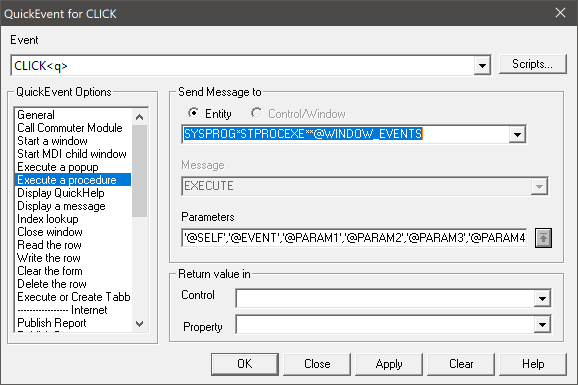The COMMUTERMODULE Property
Following this methodology offers several important advantages:
- Simplified code management
- Simplified deployment
- Improved code sharing via internal subroutines
- Lower memory overhead (single procedure vs. multiple event scripts)
While using a commuter module like this is the recommended way of developing applications in OpenInsight, there has never been any sort of formal link between the commuter module and the form itself, which means that it is usually necessary to adopt a naming convention for this approach to work.
For example, it is common to have a commuter module with the same name as the form, or with the same name as the form and suffixed with the string “_EVENTS”. By doing this it was easy to define quick-events to call the commuter module in the old v9 Form Designer like so:

v9 Commuter Module Quick Event
The OBJ_CALL_EVENT program looks for a stored procedure with the same name as the form, or one with the same name as the form and suffixed with “_EVENTS”. It was also possible to avoid the overhead of a lookup and call the commuter module directly by using the “@WINDOW” placeholder like this:

v9 Commuter Module Quick Event (using @WINDOW)
Or the “@WINDOW_EVENTS” placeholder like this:

Of course, even with this approach the form still wasn’t actually linked to it’s commuter module, rather it was only linked to “OBJ_CALL_EVENTS” or a fictitious entity called “@WINDOW”.
In version 10 we’ve added a new WINDOW property called COMMUTERMODULE, which simply contains the name of the stored procedure to use (this can be any valid name – you are no longer limited to one based on the name of the form, though we do suggest you keep this convention to help organize your application):

CommuterModule Property
When the form is saved and compiled this stored procedure is linked to the form with a “used-by” relationship, thereby making deployment easier as you will see the link when you create your RDK definition records.
Another benefit of this is that you can quickly open your commuter module from the form by using the “View Commuter Module” button on the Form Designer toolbar:

View Commuter Module button
Finally you can easily set your quick events to call your commuter module in the Event Designer like so:

Commuter Module QuickEvent
Note that it uses an “@COMMUTER” placeholder – this is replaced with the contents of the COMMUTERMODULE property at runtime.
(You can still use the previous @WINDOW/_EVENTS or Obj_Call_Events methods if you wish – those options still exist.)
So, this is the first step in tightening the relationship between a form and it’s commuter module. There is certainly scope for more integration between the two and this is something that we hope to pursue during subsequent releases.
(Disclaimer: This article is based on preliminary information and may be subject to change in the final release version of OpenInsight 10)

